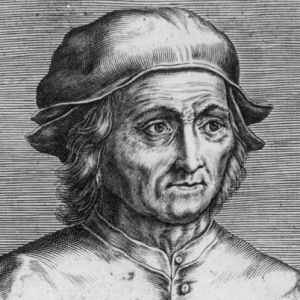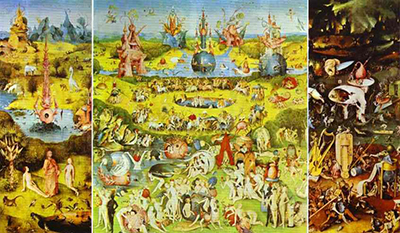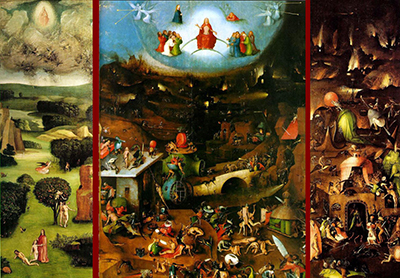 If there's one artist who might never find their way into a picture frame on most peoples' bedroom wall, it's Hieronymus Bosch. While there's no denying the talent of this Dutch Renaissance artist - once referred to as 'the devil's painter' - anyone who has seen works by Bosch will know that his creations could inspire nightmares in the hardiest of horror film fanatics.
If there's one artist who might never find their way into a picture frame on most peoples' bedroom wall, it's Hieronymus Bosch. While there's no denying the talent of this Dutch Renaissance artist - once referred to as 'the devil's painter' - anyone who has seen works by Bosch will know that his creations could inspire nightmares in the hardiest of horror film fanatics.
If you're feeling like indulging in some skin-crawling art though, you'll want to have a read of this guide we've pulled together - you can consider it a crash course in everything Bosch...
Despite his fame today, not a great deal is known about Bosch's early life. It's thought that he was born in the year 1450, but the precise date isn't known. We also can't be sure of where, how and when Bosch received his painting education, as he left behind no diaries or letters detailing his experiences. What we do know is that his birth name was Jheronimus and that his last name stemmed from his hometown, Den Bosch, or to give it its full tongue-twisting title, 's-Hertogenbosch.
Bosch died in 1516 and was buried in 's-Hertogenbosch. Over the course of his life, he produced a number of triptychs, diptychs and small panel paintings, mostly using oak panels and oil paint. Many of his surviving paintings are details or fragments of larger works which have sadly been lost. He also produced a number of drawings, many of which were preparatory sketches for his paintings.
Anyone who is even a little familiar with Bosch will associate his name with surreal, disturbing images of death and torture. Naturally, as a Dutch painter working during the 15th and 16th centuries, he was concerned largely with religious motifs and narratives, but even today many art historians question Bosch's particular motives in creating the kinds of paintings he did.
Bosch has at points been accused of painting to amuse and titillate; other historians and critics have decried his works as heretical. Today, it's more widely accepted that Bosch's paintings - though bizarre to the modern eye - were in keeping with religious beliefs of the period in which he was working.
Considered this way, Bosch's visions of heaven and hell were conjured not from a desire to arouse or inspire sinful thoughts, but from 15th and 16th century notions about morality, sin and salvation. Certain experts have even argued that Bosch's strange images are visual representations of stories from biblical and folkloric metaphors of the day.
 The most famous of Bosch's paintings is a triptych entitled 'The Garden of Earthly Delights'. It was created at some point between 1490 and 1510 and consists of three panels.
The most famous of Bosch's paintings is a triptych entitled 'The Garden of Earthly Delights'. It was created at some point between 1490 and 1510 and consists of three panels.
Over two metres high and three metres wide, this fascinating work currently resides in the Museo del Prado in Madrid. Unlike a traditional painting held in a picture frame, this work folds in on itself, the two outer panels closing over the central square to reveal another image on the exterior.
The painting on the exterior depicts what is commonly thought to be the creation of the Earth. The triptych
contained inside, meanwhile, is understood to be presented in chronological order; starting with the left panel, art historians generally agree that Bosch is presenting the garden of Eden, the titular garden of earthly delights, and lastly, Hell.
In the left panel, God has a clear presence, foregrounded at the bottom between figures we can take to be Adam and Eve. In the central panel, no such godly figure can be found; instead the scene is overpopulated with nude men and women, engaged in pleasure-seeking activities.
From this central image, the eye's movement into the third and final panel comes with a shock - gone are the paradisiacal green fields and blue skies; instead we find ourselves in the kind of hellscape Bosch is so well-known for. The background depicts smoking black mountains, and in the foreground is a harshly-lit scene in which nude figures - closely resembling those who cavort in the central panel - are being tormented, humiliated and even wholly consumed by strange, other-worldly creatures.
Reading the panels from left to right in this manner, Bosch's message starts to become clear - without the presence of God in your life, the descent into torment is inevitable.
 The same kind of fantastical beasts depicted in 'The Garden of Earthly Delights' can be found in another of Bosch's triptychs, 'The Last Judgement'. Once again, the left panel depicts Eden, showing the creation and temptation of Eve. In the central panel, the Last Judgement is depicted. As we can see, the damned have already begun to receive their punishment - which variously involves being impaled, burned and tortured by bizarre and terrifying creatures. In the right panel, this torment is continued, but here the action is overseen by Satan instead of Jesus.
The same kind of fantastical beasts depicted in 'The Garden of Earthly Delights' can be found in another of Bosch's triptychs, 'The Last Judgement'. Once again, the left panel depicts Eden, showing the creation and temptation of Eve. In the central panel, the Last Judgement is depicted. As we can see, the damned have already begun to receive their punishment - which variously involves being impaled, burned and tortured by bizarre and terrifying creatures. In the right panel, this torment is continued, but here the action is overseen by Satan instead of Jesus.
A similar narrative to 'The Garden of Earthly Delights' can be found in Bosch's triptych 'The Haywain', while a four-panelled piece entitled 'Visions of the Hereafter' pits scenes of Hell against scenes of Heaven.
In many of Bosch's other works, the hellish creatures he is known for depicting are not present, but we see a similar preoccupation with sin, torment, ugliness and the potential for salvation.
If you find yourself intrigued by Bosch and would like to learn more about his work, a good place to start is by viewing his paintings in person. His works are scattered in several galleries across the world, with 'The Garden of Earthly Delights' and 'The Haywain' both held in the Prado. If a trip through Europe seems unrealistic, don't forget that it's easier than it's ever been to bring art into your home, by ordering high quality prints of your favourite works and getting them framed for your walls.
At EasyFrame, you can choose the exact style and dimensions of your picture frame and mount - after all, Bosch's visions of Hell might be ugly, but your frame doesn't have to be!
To learn more, visit our picture frames and mounts page.
Article Posted: 18/09/2023 12:32:14